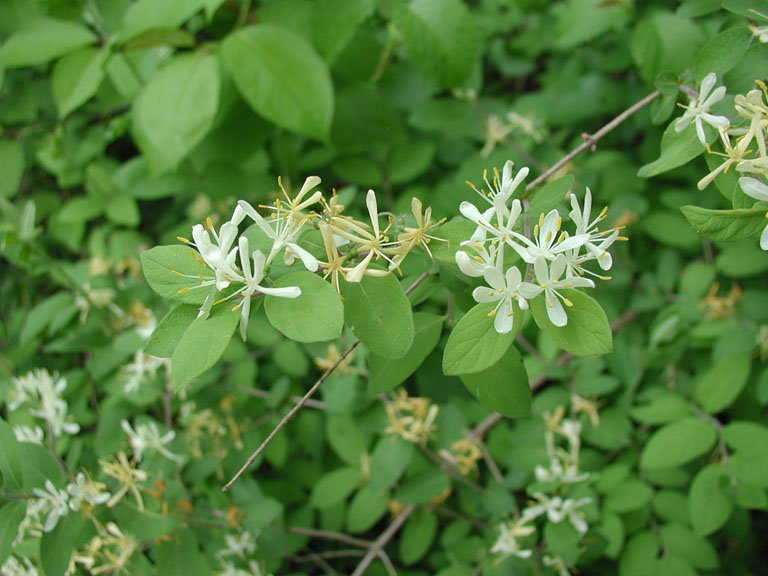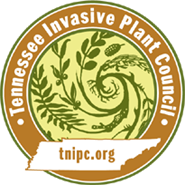Lonicera morrowii Gray
Morrow's Bush Honeysuckle| Category |
|---|
| Shrub |
|
Similar Species May be confused with the following native and/or non-native species. Landscape Alternatives lists native horticultural substitutes |
Diervilla sessilifolia Lonicera spp. Symphoricarpos orbiculatus Landscape Alternatives |
|---|

Description
Height
All species of bush honeysuckles grow to heights of 6-20 feet (1.8-6.0 m). Morrow's is the shortest at 6-8 feet with a similar or slightly wider spread. January jasmine is 6-10 feet in height and width. Belle is 8-10 feet tall with a similar or slightly wider spread. Tatarian is 10-12 feet with a 10 foot spread. Amur is the tallest reaching 12 to 15 feet or more with a similar spread.Twigs
The twigs of all the bush honeysuckles are generally smooth, however, the new twigs of Amur and Morrow are pubescent in young but lose this character with age. Most species have a hollow brown pith when mature, but January jasmine has white pith. The leaf scars are small and inconspicuous. The buds are blunt to acute. Honeysuckles are opposite branched, and bark is tan with a braided-strand appearance, sometimes flaking.Leaves
Leaves of all these species are opposite, elliptic or ovate to lance-ovate and leaf margins are entire. Foliage is typically persistent into winter. Amur honeysuckle's leaves are typically twice as long as wide and taper to a long point. Morrow's leaves are softly hairy underneath. January jasmine leaves are nearly as wide as long and have bristlelike hairs on the midvein below. Tatarian's leaves may be somewhat heart-shaped at the base and smooth underneath. As a hybrid, Belle honeysuckle may have characters of either parent - Morrow and Tatarian.Flower
The differences between the flowers of these species are dependent on corolla and pedicel length. Tartarian honeysuckle is typically pink but may vary from red to white. Amur and Morrow's honeysuckle flowers are white, changing to yellow. Belle honeysuckle may vary between the character of both parents. These species flower in May-June. January jasmine flowers in late winter with lemon-scented and extremely fragrant white blossoms.Fruit
The round berries are typically dark red, occasionally yellow, and found in pairs in the axils of the leaves. They may remain on the shrub through winter. Each berry contains 2-6 seeds. Fruit matures September-October. The fruit of January jasmine is also red and matures in late spring or early summer.For a detailed description of individual species refer to Rehder, A., Manual of Cultivated Trees and Shrubs, 1986 or Michael Dirr's Manual of Woody Landscape Plants, 1990, 1998.
Images
Photo: Leslie J. Mehrhoff, University of Connecticut, Bugwood.orgMore images of Lonicera morrowii
Life History
Bush honeysuckle species are in the Caprifoliaceae or Honeysuckle Family. The distribution of bush honeysuckle seeds is primarily accomplished by birds and small mammals. Following a period of cold stratification, seeds germinate in areas of sparse vegetation and can tolerate moderate shade but produce more seeds in full sun. It is suspected that bush honeysuckle produces an allelopathic chemical that suppresses the growth of surrounding vegetation. Leaves appear early in the spring and remain into late fall, giving bush honeysuckle a competitive advantage over native plants. Bush honeysuckles form dense thickets in open forests, forest edges, abandoned fields, pastures, roadsides, and other open upland habitats. Seeds are long-lived in the soil.Habitat
The bush honeysuckles are tolerant of a variety of soil and environmental conditions. Typical habitats include disturbed successional communities, wetlands, prairie, woodland edges, and partially closed forests. Most communities found in natural areas have the potential to support a population of one of the bush honeysuckle species. These shrubs are moderately shade tolerant, taking advantage of canopy gaps created by wind throw or insect defoliation. Honeysuckle bushes are commonly found growing under trees, tall shrubs, and along fence rows that act as perch sites for birds.Origin and Distribution
Most bush honeysuckles are native to Asia. Tatarian honeysuckle's native range is central Asia and southern Russia and was first cultivated in North America in 1752. Morrow's and Amur honeysuckles were introduced into the U.S. in 1875 and 1855 respectively. January jasmine was introduced in 1845. Bush honeysuckles were unfortunately promoted by state and federal agencies to improve wildlife habitat and as a popular ornamental.Other states where invasive:
January jasmine - VA.
Morrow's honeysuckle - MO, WI, MI, IN, KY, OH, WV, NC, VA, NJ, PA, NY, VT, NH, ME, CT, MD, DE, MA. Federal or state listed as noxious weed, prohibited, invasive or banned: CT, MA, NH, VT.
Tatarian honeysuckle - AR, NC, VA, KY, IA, WI, IL, IN, MI, OH, PA, MD, DE, NJ, CT, NY, VT, NH, RI, MA. Federal or state listed as noxious weed, prohibited, invasive or banned: CT, MA, NH, VT.
Belle honeysuckle - WI, IL, MI, NC, VA, MD, PA, NY, VT, NH, ME, CT. Federal or state listed as noxious weed, prohibited, invasive or banned: CT, MA, NH, VT.
Amur honeysuckle - WI, MO, MI, IN, OH, KY, PA, VA, GA, MD, NJ, CT, VT, DE. Federal or state listed as noxious weed, prohibited, invasive or banned: CT, MA, VT.
Sources: Information on this plant page derived primarily from the Tennessee Management Manual and James H. Miller's Nonnative Invasive Plants of Southern Forests, USDA Forest Service.
Management Recommendations
Mechanical Controls
Grubbing: This method is appropriate for small initial populations or environmentally sensitive areas where herbicides cannot be used. Using a pulaski or similar digging tool remove the entire plant, including all roots. Juvenile plants can be hand pulled depending on soil conditions and root development. Larger stems, up to 6 cm (2.5 in), can be removed using a Weed Wrench or similar uprooting tools. Any portions of the root system not removed may resprout. All plant parts, including mature fruit, should be bagged and disposed of to prevent reestablishment.Herbicidal Controls
Foliar Spray Method
This method should be considered for large thickets of bush honeysuckle where risk to non-target species is minimal. Air temperature should be above 65°F to ensure absorption of herbicides.Glyphosate: Apply a 2% solution of glyphosate and water plus a 0.5% non-ionic surfactant to thoroughly wet all leaves. Use a low pressure and coarse spray pattern to reduce spray drift damage to non-target species. Glyphosate is a non-selective systemic herbicide that may kill non-target partially-sprayed plants.
Triclopyr: Apply a 2% solution of triclopyr and water plus a 0.5% non-ionic surfactant to thoroughly wet all leaves. Use a low pressure and coarse spray pattern to reduce spray drift damage to non-target species. Triclopyr is a selective herbicide for broadleaf species. In areas where desirable grasses are growing under or around bush honeysuckle, triclopyr can be used without non-target damage.
Cut Stump Method
This control method should be considered when treating individual bushes or where the presence of desirable species precludes foliar application. This treatment is effective as long as the ground is not frozen.Glyphosate: Horizontally cut bush honeysuckle stems at or near ground level. Immediately apply a 25% solution of glyphosate and water to the cut stump, covering the outer 20% of the stump.
Triclopyr: Horizontally cut bush honeysuckle stems at or near ground level. Immediately apply a 25% solution of triclopyr and water to the cut stump, covering the outer 20% of the stump.
